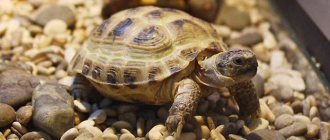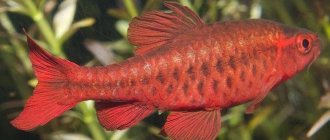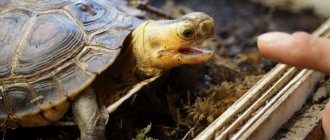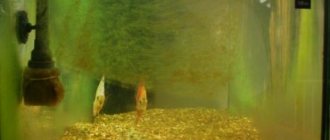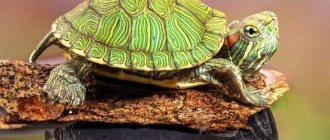Turtles attract attention because they lead a calm and measured lifestyle, without creating unnecessary noise and not requiring special attention. They are not carriers of various diseases, and care comes down to providing her with conditions for a normal life. Therefore, caring for such a turtle will not be difficult if there are children in the family. As a rule, caring for a pet turtle is a priority for children, not adults, especially since children pick up on everything very quickly and can do it much better than adults. The main thing is to explain everything to them in time; as a rule, once is enough.
Types of land turtles
The most common in Russia is Central Asian. There are 37 varieties in nature. Distributed in Africa.
Central Asian
In nature they hibernate. Small in size - up to 20 cm. The carapace is rounded, yellow-brown. Diet: 90% plant based.
Mediterranean
The young of this breed do not survive well when kept at home. Choose an adult. It feeds on earthworms, snails, and plant food. Grows up to 28 cm. The carapace scutes form rings with a dark outer edge.
Coal (red-legged)
Requires high humidity and temperatures from 27 degrees. Grows in captivity up to 55 cm. Food: fruits, vegetables, meat.
Leopard print
A body of water is required. A large turtle grows up to 60 cm. The color of the shell is light brown with dark spots. The diet consists of only grass. Juicy vegetables and fruits are dangerous to health.
Radiant
Size up to 40 cm. Very beautiful domed shell. The dark scutes have yellow spots in the shape of stars. The diet contains green parts of plants.
Other types
gear
red-headed flat
star-shaped
ivory
musky
Balkan
Egyptian
Purchase and selection
The best-selling breed is the Central Asian. Small in size, does not require special care. Larger turtles are not as easy to keep. They will need a separate large area.
Tips for choosing an animal:
- The phase of greatest activity occurs in the morning and evening. Turtles are also most active in the warm summer months. At this time, it is clear that a healthy pet is offered for sale or a sick one. Note:
- behavior, coordination and activity;
- no damage;
- color without strange spots;
- shell scutes tightly adjacent to each other;
- body shape;
- plaque in the mouth, it should not be there, just like viscous saliva;
- dry nose (discharge indicates illness).
- Try to find professional breeders.
- Choose a juvenile or adult turtle. The baby will require additional care and is susceptible to diseases.
In summer, you can transport the turtle in a cardboard box filled with paper. In winter, place a heating pad in the carrier.
Hygiene
Basic hygiene is important for everyone, including reptiles. Land animals love to dig into the litter located at the bottom of the terrarium, and the corners of their mouths get dirty with food particles, so turtles should be looked after and washed regularly.
The bathing process is quite simple:
- You need to add a teaspoon of soda to one liter of warm water.
- Pour the water into a convenient container (preferably a special bath for turtles).
- Gently lower the pet, leaving the head on the surface.
- Leave in water for 20 minutes.
- After the time has passed, remove the turtle and let it dry.
After water procedures, it is necessary to lubricate the reptile’s head and paws with olive oil.
In small turtles and hatchlings, the drying process is much faster than in adults. Therefore, babies should be bathed a little more often - 2-3 times a week.
ATTENTION! When bathing a turtle, the air temperature in the room should not be less than 23°C. Otherwise, your pet may catch a cold.
How to keep a land turtle
The most common mistake that turtle owners make is keeping it on the floor. Possible consequences:
- colds from drafts and cold coverings;
- may crawl into a corner and not get out or get stuck under furniture;
- dust getting into the nose will damage the lungs and respiratory tract;
- receiving a variety of injuries if, for example, the owner steps on it carelessly.
A specially equipped place of residence is required - a terrarium.
Terrarium
Caring for a land turtle at home begins with arranging the home. A cardboard box is also suitable as a temporary option, but you need to set up a terrarium for your pet:
- Sizes from 100 cm in length, 50 in width and 30 in height will allow the animal to move freely and eliminate the possibility of escape.
- When arranging, leave plenty of free space. Avoid creating unnecessary barriers.
- Install the future home in a warm place at a height of 20 cm from the floor to protect it from drafts.
- Leave room for a mini pool or large drinking bowl. The turtle is able to absorb water from the outside. Liquid improves bowel function.
The larger the pet, the larger the size of the terrarium required.
If you choose a former aquarium for your home, wash it thoroughly with disinfectant solutions.
Priming
Start arranging the terrarium by covering the bottom. Aquarists prefer several options:
- A mixture of earth and coconut fibers. If the soil is not purchased, first heat it to get rid of parasites.
- Sawdust. This filler is sold in pet stores.
- Coarse gravel.
- Special substrates. Formulations for reptiles are allowed.
The thickness of the layer is from 3 to 15 cm. It changes as it gets dirty.
And also put large flat stones in the terrarium. The turtle will bask on them and grind off its claws.
Do not use sand and small stones as soil; turtles swallow them and get a blockage in their intestines.
Water
Install a special drinking bowl with fresh, warm drinking water in the terrarium. To maintain the temperature of the liquid, place it under a lamp.
For the drinking bowl, take a large, heavy and almost flat container. Low sides will allow easy access to the water, and the weight will prevent it from tipping over. Keep the water level no higher than the middle of your pet's shell.
How to care for land turtles at home
Care is simple, follow a few rules and the animal will be active and healthy:
- Keep your terrarium clean.
- Diversify your diet.
- Bathe your pet every week.
- Watch the claws and beak.
- Take walks.
Feeding
The basis of the diet of a land turtle is plant foods:
- 75–80% greens;
- 20–25% fruits and vegetables.
A serving is half the turtle's body volume.
In warm weather, be sure to provide outdoor plants and wash them thoroughly so as not to infect the turtle with worms. Especially useful for the animal:
- Dandelion. All parts of this plant contain vitamin A, which is essential for your pet.
- Plantain leaves. The high fiber content helps improve bowel function.
- Salad. Your favorite delicacy can also be grown in pots in winter.
And also suitable: clover, leaves of coltsfoot, sorrel, petunia, honey, thistle and rhubarb leaves.
Among vegetables, turtles eat carrots, cucumbers, zucchini, bell peppers, and pumpkin. It is better to grate hard vegetables, give soft ones in pieces.
Feed cabbage with caution. May cause gas formation.
Fruits in large quantities cause bloating, feed them carefully. Better than apples.
Add fresh mushrooms and legume sprouts to the food once a week to meet the protein needs of the animal.
Feed the animal from a clean surface so that soil does not get inside. Diet diversity improves health and increases life expectancy. It is convenient to prepare a salad from various herbs, fruits and vegetables. You can store it in the refrigerator, if necessary, reheat it.
Some breeds need to be fed animal products. Such as minced meat.
You cannot give:
- food from the table;
- potato;
- citrus fruits, especially peels;
- whole eggshell;
- bread;
- milk;
- grasshoppers, locusts;
- poisonous mushrooms.
Feed young turtles up to two years old daily, adult turtles once every 2-3 days.
Vitamins
A complex of vitamins and minerals can be purchased at pet stores. Follow the instructions on the package. Many people cook everything themselves.
Mineral supplements at home:
- carbonate;
- bone flour;
- ground eggshells;
- glycerophosphate.
Serving: 100 mg per kilogram of pet's weight.
The necessary vitamins A, B12, D3 must come from natural sources (UV lamp, food).
It is strictly contraindicated to give oil preparations and vitamin D2 to animals.
Drink
There will be enough drinking water in the drinking bowl. Change it every day to keep it clean. Don't forget to place it under a lamp to keep it warm.
Diet in the wild
The diet of a land turtle contains mainly plant foods:
- Dandelions.
- Vegetables and greens.
- Young twigs and shoots.
- Grass.
- Some berries, such as strawberries.
For variety, reptiles may eat small insects, snails, slugs and worms. Mushrooms can be a valuable source of vegetable protein. Studying the basics of rational reptile nutrition will allow future owners to know what to feed land turtles.
Reproduction
Age of turtles ready for mating:
- females 10–12 years old;
- males 5–6.
Mating time is from February to August.
Before mating, separate the partners for two weeks. This will increase the male's interest, as will competition in the form of another male.
Maintain the temperature at 25–30 degrees. At lower rates, the male’s sperm will not mature.
The female builds nest holes, usually 2–3, lays up to 6 eggs in each and forgets about the offspring.
Pregnancy lasts 2 months. During and after gestation, the turtle requires increased nutrition.
Place the eggs laid in the hole in the incubator. The soil layer is 18 cm, the temperature is 29–30 degrees. At high temperatures there will be early development of the baby turtle. He does not get out of the shell and dies.
It takes about two months before hatching.
How to determine gender
Sex determination is possible from the age of 1.5-2 years.
Whether an adult is male or female is determined by the following characteristics:
- Body structure. Among the same yearlings, females are clearly larger and more rounded, while the male’s body is more elongated and oval.
- Abdomen. Plastron - the lower part of the shell in females is flat or slightly convex, in males it is concave. This feature is due to the gestation of eggs.
- Spurs. Leather growths on the thighs of males contribute to fixation on the female during the mating process. The female individual does not have them.
- The back of the shell. In males, the tail is curved towards the ground and almost completely covers it. In females the score is almost invisible.
- Tail. Is a sexual organ. In females it is thin and short, in males it is long and large.
- Cloaca. The female one is shaped like an asterisk and is located close to the shell. Male - longitudinal and closer to the tip of the tail.
- Eyes. Most often, yellow eye color is a sign of a female, and brown is a sign of a male.
- Behavior. Females are calm, males are aggressive. Only males participate in fights. Males are also characterized by mating dances and attempts to mount the female.
It is impossible to determine the sex by the claws, since their condition depends on the soil. In nature, males have longer and thicker hair, which simplifies the mating process.
General characteristics of the structure
The main anatomical feature of any of the existing subspecies is, of course, the shell. The original device performs a purely protective function. Its structure allows it to withstand significant overloads.
The shell consists of two layers that have anatomical features. The first layer consists mainly of horny scutes. The second component of the shell is the abdominal ribs, collarbone and sternum fused together. Also among the distinctive external features are:
- A small head with a streamlined shape, which allows you to quickly hide it in case of danger.
- Short neck.
- The eyes of land reptiles are always directed downward.
- Instead of teeth, there is a beak, with which turtles bite off and grind food. The inner surface of the beak is covered with an abundance of convex points, which replace teeth.
- The tongue is quite short, and turtles never stick it out.
- All representatives have a tail, sometimes with a spike at the end.
- All land turtles have developed color vision, which allows them to navigate in search of food.
- Among other sense organs, hearing is well developed.
Molting in land reptiles is simply the detachment of several horny scutes from the shell.
Problems
When purchasing an exotic pet, do not forget about the following problems:
- Colds from drafts.
- Malfunctions of the digestive system due to ingestion of soil.
- Excess vitamins lead to diseases.
- Improper maintenance reduces lifespan.
Diseases
Pet turtles are easily susceptible to various diseases. Most often, owners encounter the following varieties:
- Rickets. The most common. Softening and deformation of the shell and skeleton due to lack of vitamin D. Use a UV lamp to prevent and treat. In advanced cases, a series of calcium injections will be required. Once the carapace is bent, it no longer straightens out.
- Tearfulness, swelling of the eyes. Develops due to a lack of vitamin A. Wash your eyes with chamomile infusion and drip Albucid. Contact your veterinarian, sometimes vitamin injections are required.
- Parasites. Through unwashed street vegetation, worm eggs enter the turtle. Treat with Albenazole.
- Cold. Breathing problems, white coating on the mucous membrane and viscous saliva. Treated with antibiotics.
You can avoid many diseases if you properly care for your pet.
Consult your veterinarian before treatment.
Hibernation
Regarding hibernation when kept at home, experts have not come to a common opinion. Some aquarists believe that hibernation should be like in nature. Others argue that when kept at home, such wintering is not necessary and even harms the health of the pet if the preparation is not carried out by a specialist.
Preparing for hibernation turtle:
- refuses food;
- becomes lethargic;
- trying to dig into the ground.
Under natural conditions, hibernation occurs in two cases:
- Drought. Lack of food.
- Cold or excessive heat.
Check the living conditions, feed your pet and adjust the temperature.
Pros and cons of home keeping
In order to understand whether a land turtle is suitable for keeping in the house, it is necessary to consider their advantages and disadvantages.
The advantages of these pets are:
- Unpretentiousness and ease of care and maintenance. It is enough to equip the simplest enclosure or terrarium and feed it once a day.
- No allergies. These pets have never caused irritation to the skin or respiratory tract of anyone.
- Minimum costs. They are inexpensive to purchase and their maintenance requires minimal investment, since turtles eat little and mostly greens, which in the summer, for example, can be collected at the dacha or in the park.
- Long lifespan. Land pets live at least 30 years.
- Safety for household members. This very peaceful creature is not capable of causing damage to people, other pets, or things and furnishings in the house.
The disadvantages of keeping land turtles include:
- Uniformity of behavior. These pets can hardly be called cheerful and playful. They do not run around the house or act as companions in entertaining children. They just quietly live their lives and you can only slowly watch them.
- Difficulty in overcoming pathologies. If these pets get sick, it is usually very difficult to cure them. There are very few herpetologist specialists in Russian veterinary clinics.
- Low level of cleanliness. Fungus often forms on turtle shells. And when they walk around the house, you have to collect waste products from them.
- Night noise. These reptiles love to make noise at night; the grinding noises can be very annoying for people with light sleep.
But all these disadvantages are easily leveled out if you position the terrarium correctly and properly care for your pet.
Price
The cost of an individual varies from 200 rubles to 150,000 or more for rare species. The refusenik can be found on websites for free.
| Name | Price (rubles) |
| Greek, Mediterranean (Testudo graeca) | 2160–4800 |
| Leopard, Panther (Stigmochelys pardalis) | 3840–7680 |
| Indian starfish (Geochelone elegans) | 5000–12000 |
| Redfoot, Charcoal (Chelonoidis carbonaria) | 3840–4800 |
| Madagascar radiata (Astrochelys radiata) | 24000 |
| Central Asian (Agrionemys horsfieldii) | 500–3000 |
Prices depend on characteristics:
- floor;
- age;
- rarity of the species.
Compatibility
Turtles are loners. In their natural environment, they gather in groups for mating and fighting. Keep turtles together only if there is no other option and they are of the same species and size. But even then conflicts arise. Different breeds require different conditions of maintenance.
Keep exotic turtles separately.
They can coexist with some iguanas in large vertical terrariums. If you try to make friends with a small reptile, the latter may lose its tail or paws. Turtle secretions are poisonous to snakes.
Taming
To help your turtle eat from your hands, feed it while holding the food with your fingertips. Remember, once your pet gets used to this way of eating, it will begin to chase its owner.
Initially, turtles are not very friendly towards people. To wean your animal from biting, pick it up more often without making sudden movements.
Turtles have excellent hearing; when giving food or before bathing, make the same sound and the pet will begin to respond to it.
Animals remember and recognize their owner. They love to watch what is happening in the room.
Habits are quickly formed regarding feeding times and daylight hours. Not receiving food at the usual time, the pet will sigh and move its head in disappointment.
Video
And finally, here is an interesting documentary about turtles.
Author: Pavel Chaika, editor-in-chief of Poznavaika magazine
When writing the article, I tried to make it as interesting, useful and high-quality as possible. I would be grateful for any feedback and constructive criticism in the form of comments on the article. You can also write your wish/question/suggestion to my email [email protected] or Facebook, with respect, the author.
Author page
What not to do
- Color the shell.
- Allow it to hibernate.
- Give medications without consulting a specialist.
- Accommodate a new resident without quarantine for a month.
- Allow animals to play with the turtle.
- Keep the turtle on the floor.
- Leave without a shelter house.
- Use fabric, cotton wool, or wool instead of primer.
- Place aggressive pets together.
- Constantly feed the same thing.
- Cat, dog, human food.
- Animal food.
Reviews from aquarists
Reviews from owners are varied. Someone expresses complete delight, another begins to hate the animal.
Adviсe
- The turtle will not play like a cat or dog.
- Protect your pet from drafts, feed it a variety of food, and treat it on time.
- Think carefully about the purchase, because the pet lives quite a long time, and if released into the wild, it will die in the natural conditions of central Russia.
Turtle is a great choice for people who don't like noise. A leisurely turtle relaxes and clears the mind of hustle and bustle, and taking care of it brings true pleasure.
Previous
Inhabitants of the 12 most popular species of snails in the aquarium
Next
Inhabitants7 main components for feeding the red-eared turtle
Description and natural habitat
The family of land turtles (Testudinidae) includes 16 genera and 57 species. Their sizes lie in a wide range - from small ones 10 cm long to giant ones, reaching more than a meter.
The Latin name translates as brick or tile.
Under natural conditions, the land turtle lives in Africa, Southern Europe, Central, South and North America, throughout Central Asia, preferring the steppe areas of China, Uzbekistan, and Kazakhstan. They can be inhabitants of steppes, savannas, deserts, and some species also inhabit tropical rainforests.
The soils on which these reptiles live can be sandy or loamy. Rocks and small hills are their favorite habitats, but the presence of grass and proximity to water are an indispensable condition.
As housing, turtles often choose ready-made burrows dug by other animals, but they can equip them themselves.
Despite the fact that the reptile is an inhabitant of arid zones, the soil must contain moisture. She won't be able to dig through anything too hard with her paws.
The features of these reptiles are as follows:
- Tall or flattened carapace. It is strong and durable and reliably covers the back (carapace) and belly (plastron) of the animal.
- The shell is capable of withstanding a very heavy load, more than 200 times the mass of the individual itself.
- The turtle's legs are elephant-like, short, powerful and massive, ending in fused toes and free claws.
- The tail is short, often triangular in shape with a sharp spike at the tip.
- Most species have inconspicuous colors - olive-gray or yellowish, brown both on the skin and on the shell.
- The legs, head and tail are covered with leathery scales and scutes.
- Some species, when in danger, emit sharp hissing sounds similar to those of a snake.
- This is a slow and leisurely animal. When in danger, it does not run away, but completely pulls its limbs and head into its shell.
- Another way to protect a land turtle is to suddenly empty its large bladder.
- Males are always smaller than females.
- They have a high life expectancy. For some types it is 50 years, for others 100 and even 150.


